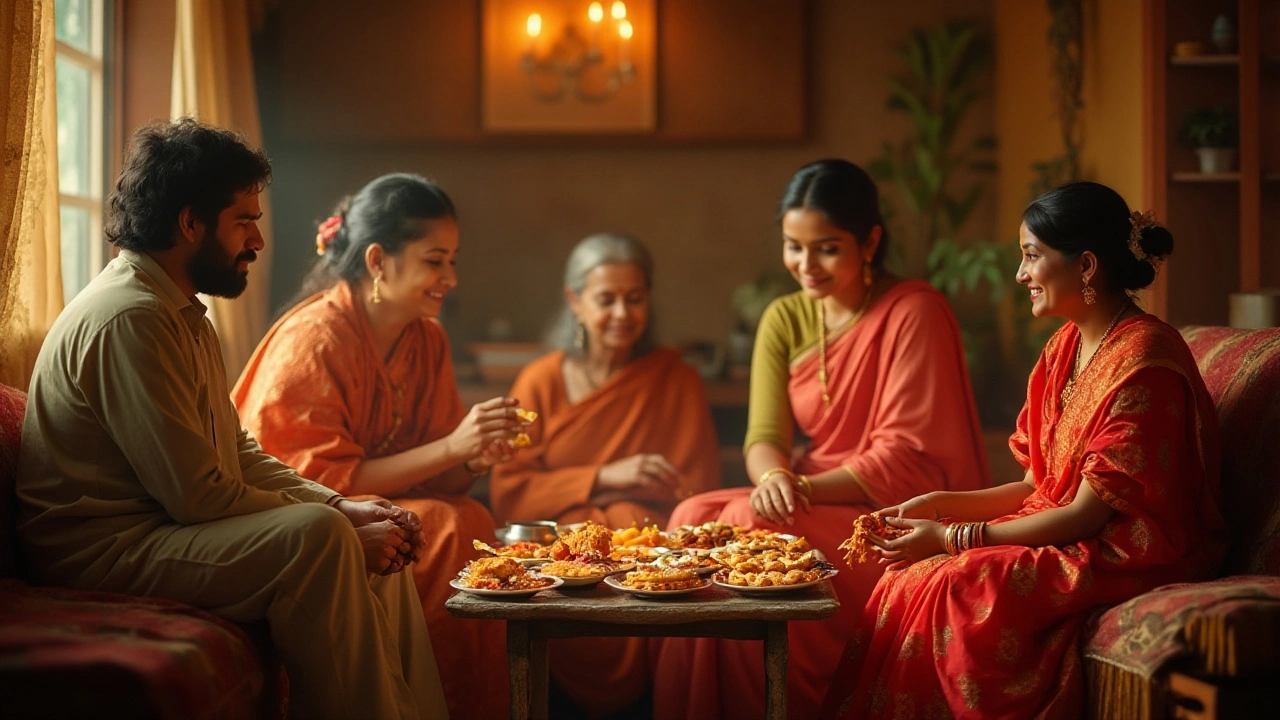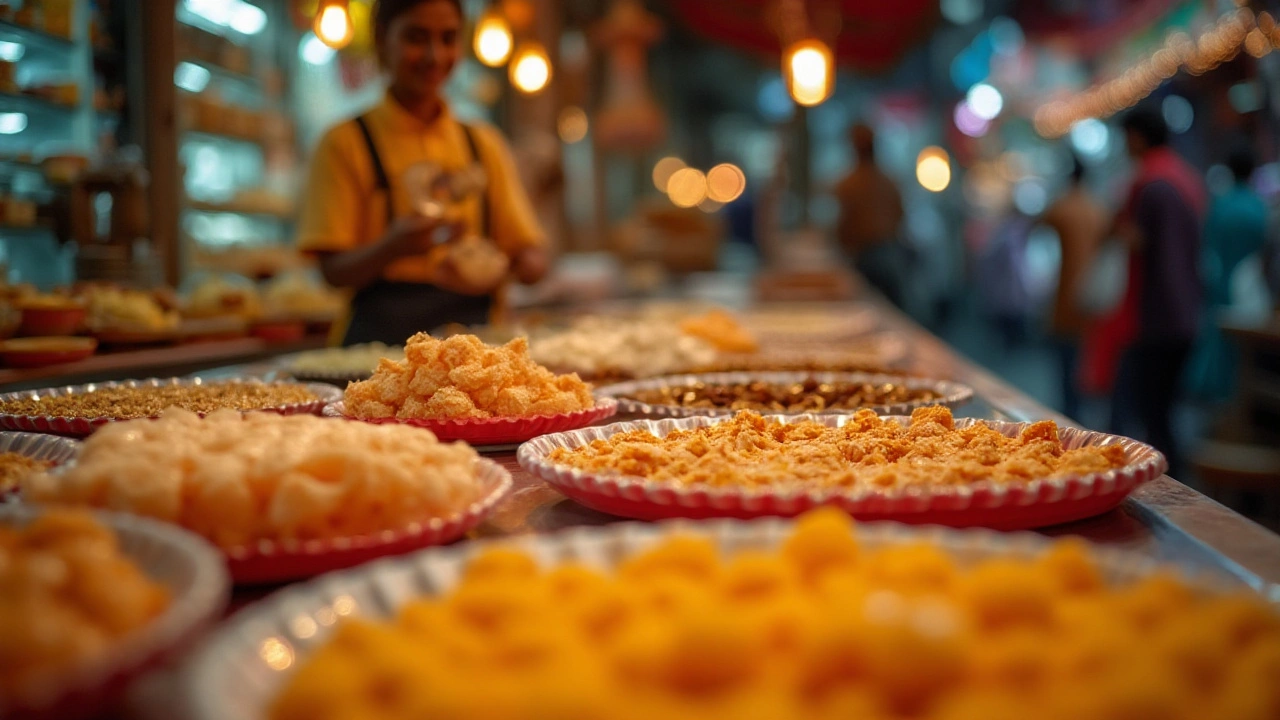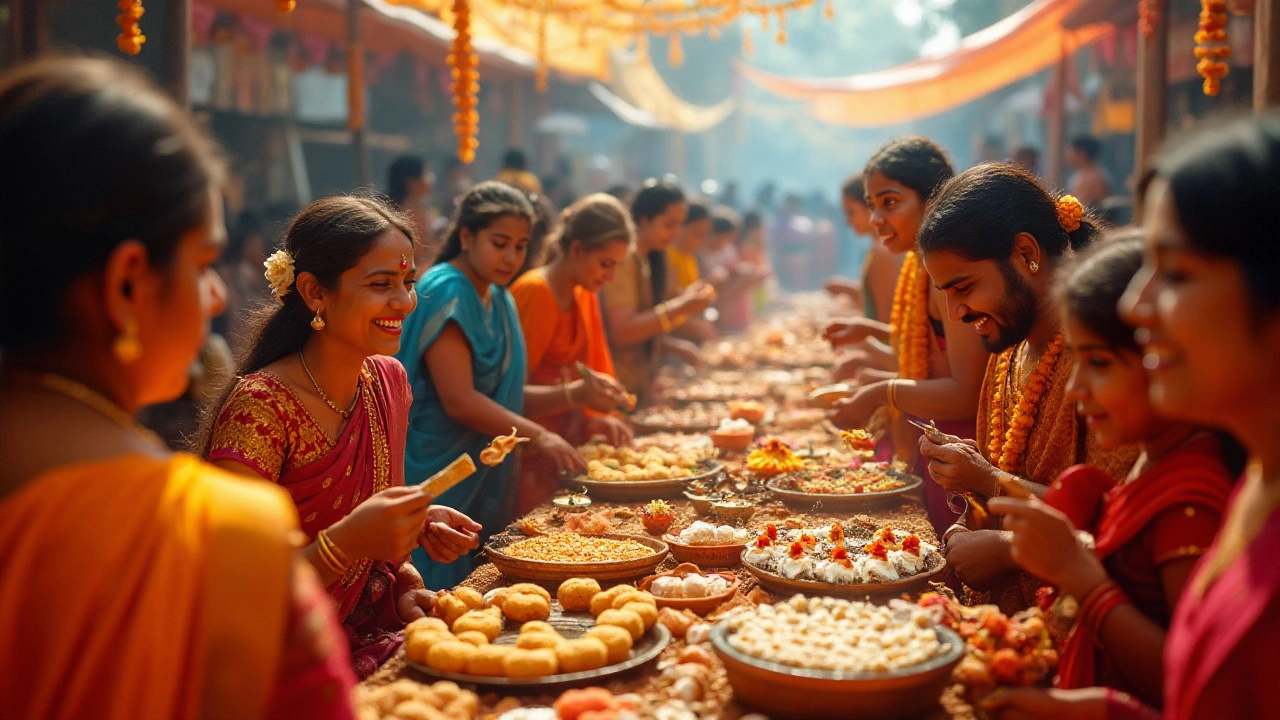In India, the affection for sweets is more than just a culinary preference; it's a beloved tradition deeply embedded in the social and cultural fabric of the nation. Every occasion, whether grand or intimate, finds a perfect complement in the delightful mithai or Indian sweets that often steal the show. From the bustling streets of Delhi to the quaint corners of a Bengali household, sweets hold a place of honor.
They aren't just sugary treats; they are a symbol of joy, celebration, and hospitality, sharing the soulful story of India’s history and varied culture with every bite. Imagine savoring a soft gulab jamun, or biting into a crisp jalebi, these sweets carry stories from ancient kitchens to modern festive tables. And as diverse as the nation itself, the types of sweets range from region to region, each with its distinctive flavor and preparation method, promising a sweet adventure like no other.
- Historical Significance of Sweets in India
- Cultural and Festive Connections
- Popular Varieties of Indian Sweets
- Health and Tradition: A Balancing Act
- Simple Recipes to Try at Home
Historical Significance of Sweets in India
The rich tapestry of Indian culture is exquisitely woven with the threads of its culinary history, and at the heart of this is the irresistible allure of Indian sweets. Known fondly as 'mithai', these sweets have journeyed through centuries, deeply engrained in the traditions and rituals across the country. This enduring love affair began long before the advent of sugar, during ancient times when jaggery and honey were the natural sweeteners. As early as 500 B.C., historical texts like the Mahabharata mentioned sweets being part of celebrations and offerings to deities, suggesting a heritage that is as much about devotion as it is about taste. During the Gupta era, considered a golden age for art and literature, sweets like the peda and barfi marked their entry, elevating the dessert games of princely feasts.
With the advent of the Mughal empire, a new chapter unfolded in the history of Indian sweets. The Mughals, known for their opulent lifestyles, introduced a range of rich, decadent confections infused with dry fruits, saffron, and rose water, mirroring the luxurious essence of their reign. It's fascinating to note how these influences combined with local traditions, creating a uniquely diverse sweet culture across various regions. Take the 'bhog', the sacred food offerings in temples; sweets like the ladoo and payasam hold religious significance, symbolizing purity and piety. A proclamation by an ancient text boldly states, ‘To share a sweet is to share victory’, highlighting their role in the celebration of triumphs and auspicious beginnings.
In more recent history, the colonial period saw the introduction of new ingredients and cooking methods that enriched the Indian dessert landscape. British-led trade brought refined sugar to Indian kitchens, transforming traditional confections and paving the way for innovation. Indians quickly adopted these changes, giving birth to desserts like the modern sandesh and rasgulla, particularly beloved in Bengal. This fusion of indigenous and foreign elements shaped what we now know as the incredible diversity of Indian sweets. And amidst this historical evolution, occasions like Diwali and Holi emerged, filled with vibrant sweets as a core feature, distributing joy and unity among families.
"Sweets are not merely for taste or indulgence—they're to be shared, to create happiness and to bring people together." — Anjali Sen Gupta, Culinary Historian
This historical bond with sweets reflects how deeply they are intertwined with the Indian ethos. Whether through myths, colonial trades, or outright love for flavors, the journey of Indian sweets is central to the national story. And today, amidst globalization, these traditional sweets continue to be cherished, adapting to modern palates while honoring their storied past. A sweet treat, in essence, is a morsel of history you can taste with every bite.
Cultural and Festive Connections
Indian sweets, or mithai, go beyond mere indulgence; they are a tapestry woven into the vibrant culture and festivities of the land. Every festival, be it Diwali, Eid, or Pongal, carries its own sweet tradition, and a joyous feast is incomplete without the customary sweets reflective of the occasion. Diwali, for instance, is synonymous with the luscious taste of kaju katli and sweets crafted from besan, which are shared with family and neighbors as tokens of goodwill. Come Pongal, and it's the sugary aroma of sakkarai pongal, cooked to perfection with love and reverence, that fills Southern homes.
This tradition is not only about the taste. It's about stories narrated over simmering pots, about heritage passed from one kitchen to another, as grandmothers teach younger generations the intricacies of achieving the perfect consistency of their famous gulab jamun. Not just about preparation, sweets are tied into the very acts of blessing and offering in religious ceremonies. Aarti plates are ceremonially adorned with Indian sweets as they’re offered to deities, believed to invite prosperity and joy. Festivals offer the perfect excuse for sweet exchanges, reinforcing bonds and celebrating life’s varied hues.
"The tradition of exchanging sweets during festivals is an expression of love and togetherness, binding communities in sweetness." - R. K. Narayan
Interestingly, the cultural link between sweets and festivities often mirrors the geographical and historical threads of the regions they hail from. For example, Bengal is renowned for its myriad of sweets like rasgulla and sandesh, deeply rooted in their aquatic surroundings, while Rajasthan celebrates its arid charm with crispy, shelf-stable sweets like ghevar. These customs narrate a rich history of adaptation and innovation, influenced by trade routes, climatic conditions, and the availability of local produce. Nowadays, despite modernization, these traditions remain vibrant, reinventing themselves to include new twists while essentially respecting their roots.
As you delve deeper into why these traditions have persisted, you'll find that sweets serve as a medium of emotional expression. Be it the joy of a newborn's arrival heralded by the distribution of pedas, or the bittersweet parting sentiment wrapped up in a box of burfi for a loved one going abroad. Besides their presence in celebrations, sweets are given as offerings to signify a personal prayer or wish, showcasing their integral role in personal and communal rituals. Truly, Indian sweets symbolize the essence that sweetness brings to life – quite literally offering a taste of happiness and shared memories, collecting cultures and communities in its warm embrace.

Popular Varieties of Indian Sweets
India boasts a rich tapestry of Indian sweets, each carrying tales of tradition and expertise from generations past. At the heart of this sweet repertoire lies the beloved gulab jamun. These deep-fried dough balls soaked in rose-scented syrup are a staple at weddings and festivals, often stealing the spotlight with their luscious texture and aromatic allure. Originating from Persian influences, gulab jamun is universally adored across the subcontinent. Similarly, rasgulla, a spongy, syrupy delicacy from Bengal, offers a contrasting bite--light, airy, and refreshingly sweet, crafted from chenna or fresh paneer, which is a testament to the region's fantastic dairy craftsmanship.
Another heavyweight in the mithai universe is the ladoo, available in myriad forms, from the nutritious besan ladoo, rich with chickpea flour and ghee, to the coconut ladoo, known for its tropical flair. Each variety brings more than just flavor; it heralds the craftsmanship of Indian confectionery skills, where patience and precision meld to create perfection. Then, there's the royal kaju katli, a diamond-shaped cashew fudge, often gifted during Diwali, symbolizing prosperity and goodwill through its luxurious taste and presentation.
Deep in the alleys of cultural exchanges, we find barfi, which brings to life a marriage of milk and sugar, sometimes spiced with cardamom or zest with saffron. It presents itself in a plethora of flavors, from plain to pistachio, to chocolate, showcasing its adaptability to different palates. Across India’s varied culinary landscapes, jalebis remain a crunchy, syrup-soaked favorite, harmoniously blending sweet and tangy, while the colorful, soft pedas from Mathura symbolize purity, frequently seen in religious offerings, indicative of their sacred significance.
"Indian sweets are more than just sugar and spice; they are a heritage mingled with joy and celebration," - Chef Gaggan AnandSweets in India aren't merely about gustatory pleasure; they are about forging connections and reaffirming bonds. For many, these sweets are not only for special occasions but a spontaneous indulgence, a heartwarming bite of comfort. Even with the advent of modern sweets and imported candies, the hold of traditional mithai remains firm, anchored deeply in the hearts and homes of millions across the globe. The art of making these delicacies often passes down through families, cherished as a sacred practice in every Indian kitchen.
As we journey through the diverse palate of Indian desserts, it's equally essential to marvel at regional specialties. The Mysore pak from the south, rich with ghee and a hint of spice, offers a melt-in-the-mouth experience, while Maharashtra's puran poli, a sweet flatbread stuffed with jaggery and gram, provides a birthing ground for contrasting textures and flavors. These are just a few amid countless creations that continue to win over hearts, ensuring every festivity, from Holi to Eid, Diwali to small kitchen triumphs, is engrained with unforgettable, sweetened memories.
Health and Tradition: A Balancing Act
Indian sweets, often referred to as mithai, are undeniably delicious — a sweet symphony of flavors, textures, and aromas that are hard to resist. But in today’s health-conscious world, they also prompt an important conversation about balance. Traditionally, these desserts are rich in ghee, sugar, and often milk products, which provide a cozy comfort that feels both nurturing and indulgent. However, the question arises: how does one enjoy these cultural delights without compromising on health?
For generations, mithai has been made using age-old recipes, believed to offer more than just momentary pleasure. Ingredients like nuts and spices enrich the sweets, not only flavor-wise but nutritionally too. Almonds, pistachios, and cashews often find their way into Indian sweets, adding healthy fats and proteins that can add a nutritional punch. Likewise, spices like cardamom and saffron are known for their antioxidant properties. Yet, awareness of the caloric density and sugar content is crucial. As with any cultural practice around food, moderation is key.
Many modern households have begun tweaking traditional recipes to make them healthier. Natural sweeteners like jaggery are increasingly substituting refined sugar. Jaggery, a traditional sugar used in making some Indian sweets, is considered by some to be a healthier alternative due to its mineral content. On the cooking front, many are opting for baking rather than frying to reduce the oil content in sweets like ladoos or jalebis. The health trend is all about balance — marrying the rich traditions of Indian sweets with modern healthy lifestyle choices.
A 2020 study by the Indian Journal of Traditional Knowledge highlights the beneficial components within some Indian sweets, suggesting that certain ingredients could promote digestive health and boost immunity when consumed wisely. It is worth noting that every festivity might bring a different set of traditional sweets, each with its seasonal and regional adaptations, which often align with what the body needs at that time of year. Seasonal sweets like tilgul and plant-based indulgences like coconut-based desserts are fascinating examples of this practice.
The sweet tradition in India is not just about satiating the sweet tooth but also about a careful and mindful incorporation of ingredients that effectively tell age-old stories through flavor.
"Sweets in India are not merely desserts. They can be tradition and medicine when enjoyed in their ancient form," as noted culinary historian K. T. Achaya once stated. Such insights prompt a cultural reflection on these delicacies. Looking forward, perhaps the best approach is to cherish these vibrant narratives and tastes, while consciously incorporating healthier tweaks.
Simple Recipes to Try at Home
There's a certain magic in the air when the scent of sugar and spice fills the kitchen as you prepare Indian sweets or mithai. These recipes not only bring the family together but also hold the potential to transport you to the vibrant streets of India with every bite. Making mithai at home can be an enjoyable experience, allowing you to bond with your loved ones while creating something delicious. Whether you’re a novice or a seasoned cook, there are some classic recipes that you can try without much fuss.
One of the easiest and most loved desserts is the Gulab Jamun. To make this decadent sweet, you'll need milk powder, flour, baking powder, ghee, and milk to form a soft dough. Small balls are then shaped from the dough and deep-fried until golden brown. These golden spheres are soaked in a fragrant sugar syrup flavored with cardamom and rose water. The syrup adds a rich sweetness and aroma, making them entirely indulgent. The joy of watching them soak and double in size, absorbing all that sweet syrup, is in itself a rewarding sight.
"The ability to make sweets from scratch is akin to art, a soulful experience that connects us with our heritage," renowned chef Ritu Dalmia eloquently noted.If you fancy something a bit different, trying your hand at Jalebi is a delightful adventure. This sweet-savory snack is beloved across the subcontinent. To prepare it, a fermented batter made from flour, yogurt, and a dash of saffron is transferred to a piping bag. Circular shapes are piped directly into hot oil with a deft hand, frying until crisp and capturing that iconic spiral shape. Once golden, these spirals are quickly dunked into sugar syrup, giving them their glistening, glaze-like coating. The result is a crunchy exterior with a softly sweet interior, a texture that's absolutely irresistible.
Besides these, Indian desserts like Coconut Laddoo can be whipped up in a jiffy for those who love coconuts. Made with just a few ingredients, such as desiccated coconut, condensed milk, and a hint of cardamom powder, the mixture is cooked gently, formed into balls, and rolled in more coconut for a truly delightful finish. The texture is chewy with an intense coconut flavor that's refreshing and captures the essence of Indian simplicity in sweet making.
For those who appreciate more traditional tastes, Kajoo Katli – a cashew fudge – is a luxurious treat that’s perfect for special occasions. This recipe involves grinding cashews into a fine powder, cooking it with sugar to form a rich dough, and rolling it out into thin, diamond-shaped pieces. Adding a sliver of edible silver leaf, known as varak, elevates its appeal both aesthetically and in terms of authenticity. Offering sweets like these during festivities symbolizes prosperity and goodwill, creating memories that last long after the sweets are gone.
